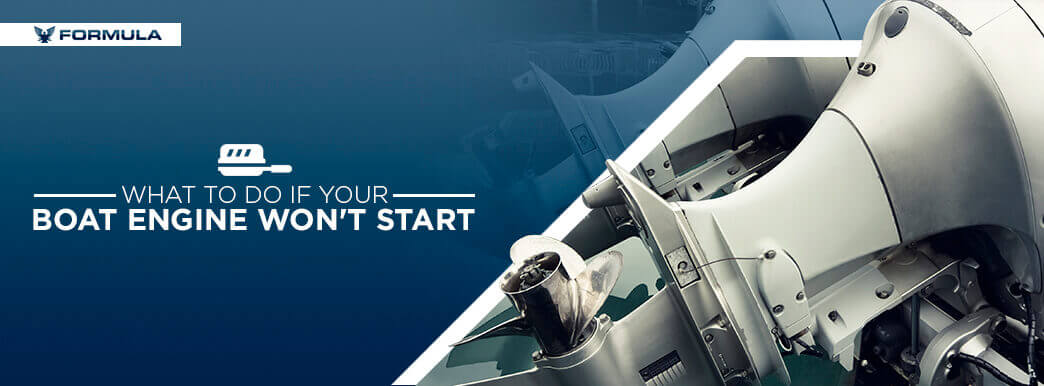
It’s a sunny summer day, you have your fishing rod in hand and you’re ready for an afternoon of fun and excitement on the water. Your friends pile into the boat, and you prepare to head out, when the worst-case scenario happens — nothing. You turn the key in your boat’s ignition, but all you hear is the sloshing of waves against the shore. Your boat won’t start.
Common Causes and Solutions for a Boat Engine That Won’t Start
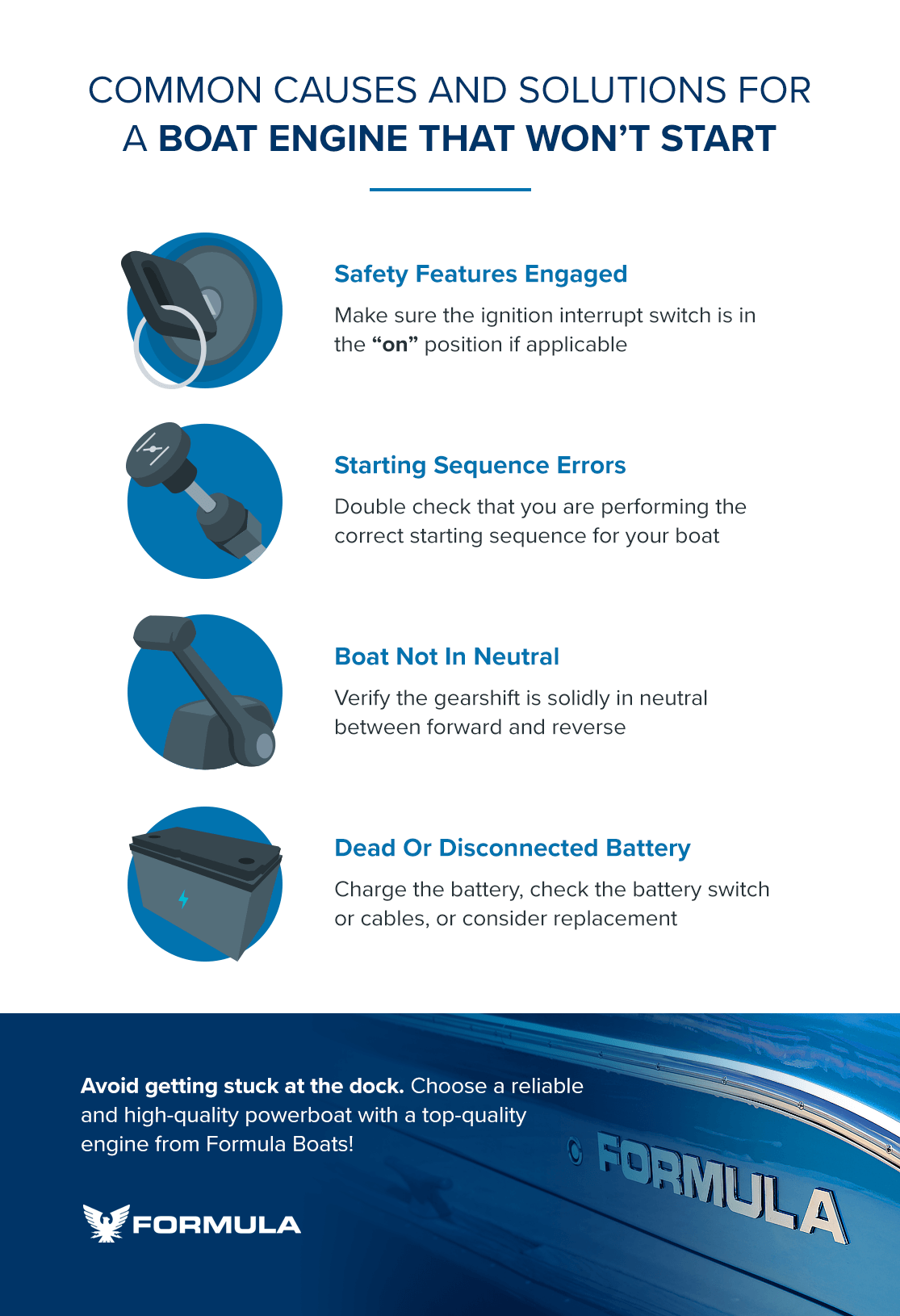
Although boat engines have become more complex as technology advances, most marine engines still operate based on the same simple principles. Boat engines need ignition, fuel, air, compression and exhaust to start up and run smoothly. If any of these elements are missing due to broken or damaged parts, your engine may not turn over and will have trouble starting. Consider this list of common reasons your boat engine won’t start to identify and correct the problem quickly.
1. SAFETY FEATURES ENGAGED
In the excitement of cruising across the water, it is easy to forget to disengage the safety features that prevent your boat from starting up. Most modern boats come equipped with a safety lanyard or ignition interrupt switch that must remain connected while the boat is running. If the safety lanyard has become disconnected for any reason, your boat engine may crank, but not fire, or it may not turn over at all. If your boat has an ignition interrupt switch, make sure it is in the “on” position.
2. STARTING SEQUENCE ERRORS
Even the most seasoned boaters make mistakes now and then. Before tearing apart your marine engine, double-check that you are performing the correct starting sequence for your boat. Depending on your engine type, you may need to choke the motor by pushing the key into the ignition or pulling out the manual choke knob on the engine. In colder weather, your boat may require a little more choke than usual to start.
If you just purchased your boat or it has been a while since you last hit the water, take a few minutes to review your boat’s manual to ensure you are performing the correct pre-ignition protocol.
3. BOAT NOT IN NEUTRAL
Most boats must be in neutral before starting the engine. If your boat is in gear, the engine will not start, but other components like the lights and gauges will work. Verify the gearshift is solidly in neutral with the lever in the middle position between forward and reverse.
4. DEAD OR DISCONNECTED BATTERY
If your starter engages, but the engine cranks very slowly, your boat battery may be low. If the engine does not turn over at all, the battery may be dead. Check the voltage of your batteries with a voltmeter and charge the batteries to about 12.6 volts for a full charge. If the battery will not charge or does not hold a charge, you may need to get it replaced.
On boats equipped with two batteries or a battery switch, make sure you have it set to “on” or “both” before trying to start your boat. While a battery switch is an excellent feature to prevent battery drain, it can also be the reason your boat won’t start if you forget to turn it back on.
If you have checked the battery switch and charged the batteries, but your boat engine still won’t start, check the battery cables. Make sure the connections that run between the engine and the battery are not loose or corroded. Reconnect or replace any battery cables that have become disconnected or damaged.
5. ENGINE NOT PRIMED
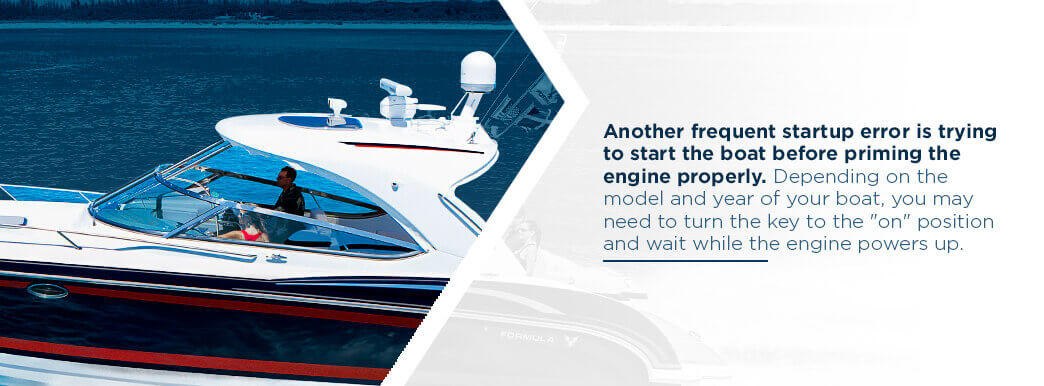
Another frequent startup error is trying to start the boat before priming the engine properly. Depending on the model and year of your boat, you may need to turn the key to the “on” position and wait while the engine powers up. If your boat does not start after allowing it to prime, make sure fuel is getting to the engine and that the primer is not damaged.
If your boat has an electric primer, check that fuel is flowing correctly by removing one of the fuel hoses that connect the primer to the carburetor or engine intake. Ask a friend or family member to push the key into the ignition to prime the engine while you watch to see if fuel comes out. Make sure to use a bucket or cup to catch the fuel and prevent it from spilling.
If your boat has a pressurized fuel system, verify it is working correctly by pumping the primer bulb. After several squeezes, the primer bulb should become firm, indicating that the fuel system is pressurized. If this is not the case, check the fuel lines, engine, tank and filters for leaks. A primer bulb with a bad valve inside can also prevent your fuel system from pressurizing adequately. If the fuel tank primer is not operating correctly, you may need to replace it before heading out on the water.
6. EMPTY GAS TANK
Another reason fuel may not be flowing to your marine engine is if there isn’t anything in your gas tank at all. Even if you’re positive you remembered to fill up after your last boating adventure, it doesn’t hurt to double-check — or to bring some extra fuel along just in case.
7. LOOSE OR PINCHED FUEL LINES
If the fuel lines in your marine engine are kinked or pinched, this will block fuel from flowing to the engine. Verify the fuel lines are not obstructed and replace any damaged fuel lines. The fuel line couplings and connectors in your boat’s engine can also come loose over time. Make sure all connectors have a tight seal, and all O-rings in the fuel system are intact. A ripped O-ring or loose connection can cause air to leak into the fuel lines and prevent the boat from starting.
8. AIR VENTS OR EXHAUST BLOCKED
Your boat gas tank requires adequate ventilation for ignition to occur. Check that all the gas tank air vents are open and not obstructed. A blocked engine exhaust is another common reason a boat won’t start — especially if you’ve recently brought the boat out of storage. During winter storage, rodents sometimes build nests in boat engine exhaust outlets, which blocks correct air flow and prevents the engine from starting.
9. WATER OR DIRT IN THE FUEL SYSTEM
Boat fuel systems can sometimes accumulate water and dust that prevent the engine from operating properly. If there is water in your fuel system, you will be able to see a separated and defined layer of water under the fuel. Drain the water and change your fuel filter. If you can see dirt accumulation in the fuel tank or filters, flush the fuel system, then refill it with new fuel.
10. CARBURETOR ADJUSTMENTS TOO LEAN
The carburetors in your boat engine control the flow of air and fuel to your engine. If your carburetors have become clogged, or you have adjusted them incorrectly, not enough fuel will reach the engine to allow it to start or run. If the carburetor has visible dirt or grime, clean it thoroughly. After the carburetor is clean, adjust the carburetor settings to provide the correct air-fuel mixture to your boat engine, then try starting the boat again.
11. FAULTY SPARK PLUGS
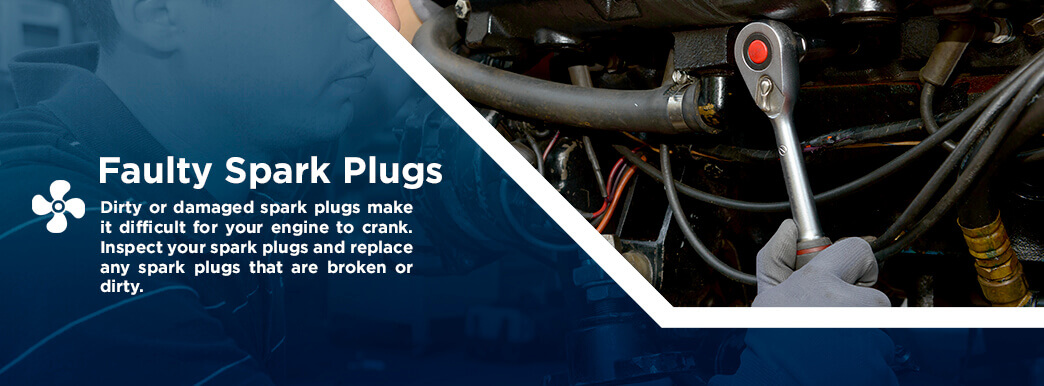
Dirty or damaged spark plugs make it difficult for your engine to crank. Inspect your spark plugs and replace any spark plugs that are broken or dirty. If the spark plugs in your marine engine are improperly gapped, this can also prevent your boat from starting by delaying engine combustion. If you have noticed your boat engine hesitating, running erratically while idling or generally performing poorly, this may be a sign that your spark plugs need an adjustment. Correct the gap setting of your spark plugs or contact a certified boat mechanic to adjust them for you.
12. IMPROPERLY GAPPED IGNITION POINTS
Similarly to your boat’s spark plugs, the ignition points in your boat’s engine must also be gapped correctly, clean and snug for your engine to start. Adjust your ignition points to the correct gap and remove any dirt buildup. If the ignition points are damaged or broken, contact a professional mechanic to perform a repair.
13. BENT MANUAL CHOKE LINKAGE
If the manual choke linkage in your marine engine is bent or dented, the engine may not start. If the bend is small, you can often readjust it using a hammer or pliers. A larger dent or structural damage to the choke linkage may require a complete replacement. If your boat’s engine has an auto choke, it may go out of adjustment and need correcting.
14. IMPROPER MOTOR TIMING AND SYNCHRONIZATION
If the timing and synchronization in your boat engine are out of adjustment, you may want to contact a professional mechanic, as your engine may have internal damage or a broken flywheel. If the flywheel becomes disconnected due to a sheared fastener or other damage, the crankshaft will not rotate when you try to start the boat, which will throw off the engine timing. A mechanic can replace the broken part to correct the motor synchronization.
15. DAMAGED ELECTRICAL INSULATION OR WIRES
Through continued wear and tear, the insulation in your boat’s electrical system can become frayed or the wires can become loose or broken. Inspect all wires and insulation and replace any that are damaged. If you are itching to hit the water, you can use electrical tape as a temporary fix for frayed insulation — however, be sure to perform a proper repair when you get back to land.
16. STICKING OR DAMAGED REED VALVES
Two-stroke boat motors contain reed valves that help control air flow to the engine. Reed valves sit below the carburetor to prevent the air and fuel mixture from leaking back out of the engine cylinder after it has gotten pushed out of the carburetor. If the reed valves are chipped, cracked or not seating correctly, air and fuel can escape from the cylinders instead of getting compressed by the pistons. This issue causes the engine to run lean and eventually makes it difficult to start.
Luckily, replacing reed valves is relatively straightforward once you have identified the damaged valve. If you believe your boat engine may have reed valves that are not sealing properly, inspect them for any visible cracks or tears. When the valves seal correctly, you should not be able to see any light coming through.
17. WEAK CONDENSER OR COIL
The ignition coil and condenser in your boat engine incur wear and tear from regular use. If you take your boat out frequently, these parts may be the reason your boat won’t start. Replace the ignition coil and condenser if they appear worn or weak.
18. DAMAGED DISTRIBUTOR CAP OR ROTOR
The distributor and rotor in your boat engine are responsible for carrying voltage from the ignition coil into the cylinders to ignite the fuel and air mixture. If the distributor cap or rotor has become damaged or cracked, your boat’s ignition will not operate correctly. Replace the damaged distributor cap or rotor, then try starting the engine again.
This list of common reasons a boat engine won’t start is a good place to begin for troubleshooting a malfunctioning boat engine. If your boat still doesn’t start after trying these solutions, contact a certified boat mechanic to inspect your engine and locate the problem.
Rely on a High-Performance Engine in Your Formula Boat
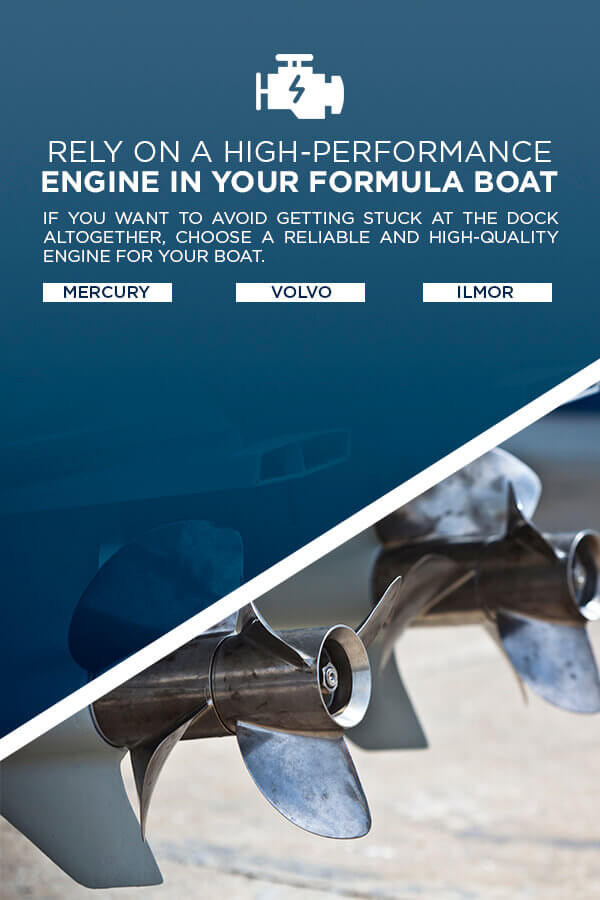
If you want to avoid getting stuck at the dock altogether, choose a reliable and high-quality engine for your boat. Although an excellent marine engine will not prevent you from forgetting to fill up your gas tank or accidentally draining the battery by playing your stereo, a quality engine will offer dependable long-term service with fewer hiccups than a lower-quality model. Top-notch boat engines are designed to provide lasting durability, exhilarating performance and smooth operation for years to come.
At Formula Boats, we make it our mission to build the best powerboats on the water. That means we construct our luxury boats with top-quality materials and the very best equipment, including your choice of a high-performance engine from one of the top marine engine manufacturers. Formula offers sterndrive and outboard engines from three premier manufacturers — Ilmor, Volvo Penta and Mercury® Mercruiser®. Each brand offers distinct advantages to suit your individual boating preferences.
- Mercury: Mercury is one of the few boat engine manufacturers that build their engines from scratch, instead of marinizing auto engines. Their boat engines offer superior corrosion resistance, excellent handling and a whole lot of speed.
- Volvo: With a focus on fuel efficiency and performance, Volvo Penta produces lightweight and durable aluminum marinized engines.
- Ilmor: Ilmor is another trusted name in marine engines, providing smooth shifting, exceptional maneuverability and all the power you need to get the most out of your Formula boat.
Because Formula powerboats are fully customizable, you can pick the perfect engine to suit your preferences for power and performance. Our marine engines range from 250 to 430 horsepower, with top speeds reaching over 60 miles per hour on some models. Whether you want to rip through the waves or prefer a leisurely cruise around the bay, Formula lets you choose how much horsepower you want and select a marine engine drive system that suits your boating style.
To provide a truly personalized boating experience, Formula Boats even offers both sterndrive and outboard engines for many of our powerboat models. Whether you prefer the sleek look of a sterndrive or value the fuel efficiency of an outboard, Formula has the powerboat engine for you.
Contact Formula Boats to Learn More
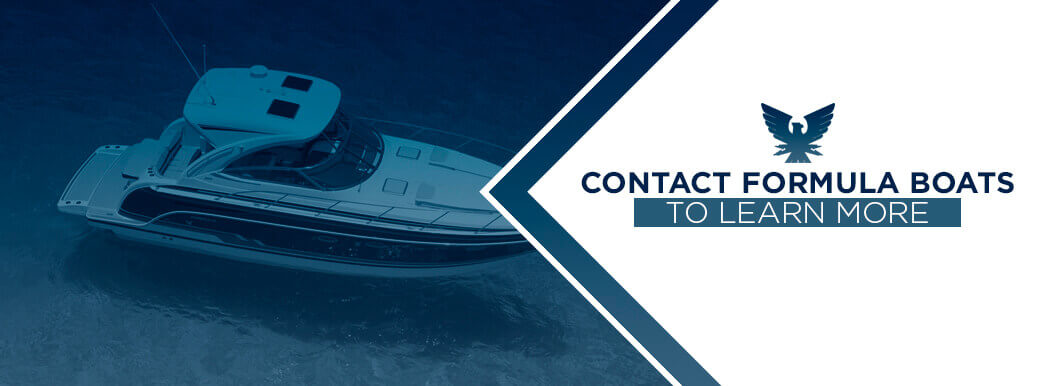
In addition to our powerful high-performance engines, Formula Boats offers many other top-of-the-line features, including custom seating areas, extended swim platforms, advanced GPS systems, shade structures, air conditioning, entertainment options, lighting features and much more. With advanced engineering and unmatched performance, Formula’s premier powerboats provide a recreational boating experience like none other. If you’re ready to hit the water in luxury and style, design your Formula boat today or contact us to learn more about building your dream powerboat with Formula.
